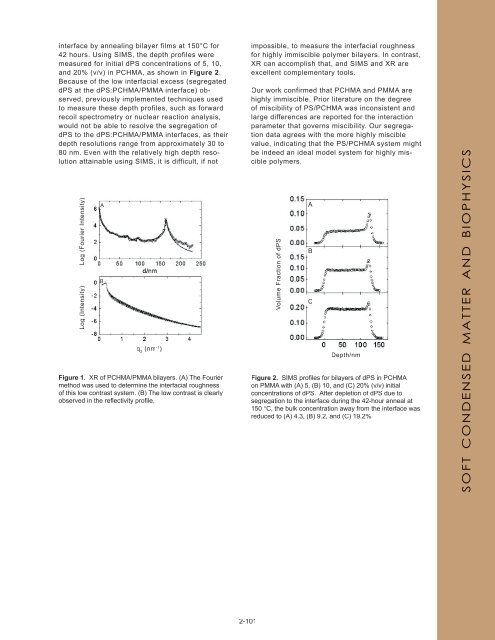NSLS Activity Report 2006 - Brookhaven National Laboratory
NSLS Activity Report 2006 - Brookhaven National Laboratory
NSLS Activity Report 2006 - Brookhaven National Laboratory
You also want an ePaper? Increase the reach of your titles
YUMPU automatically turns print PDFs into web optimized ePapers that Google loves.
interface by annealing bilayer films at 150°C for<br />
42 hours. Using SIMS, the depth profiles were<br />
measured for initial dPS concentrations of 5, 10,<br />
and 20% (v/v) in PCHMA, as shown in Figure 2.<br />
Because of the low interfacial excess (segregated<br />
dPS at the dPS:PCHMA/PMMA interface) observed,<br />
previously implemented techniques used<br />
to measure these depth profiles, such as forward<br />
recoil spectrometry or nuclear reaction analysis,<br />
would not be able to resolve the segregation of<br />
dPS to the dPS:PCHMA/PMMA interfaces, as their<br />
depth resolutions range from approximately 30 to<br />
80 nm. Even with the relatively high depth resolution<br />
attainable using SIMS, it is difficult, if not<br />
Log (Intensity) Log (Fourier Intensity)<br />
A<br />
B<br />
q 2 (nm -1 )<br />
Figure 1. XR of PCHMA/PMMA bilayers. (A) The Fourier<br />
method was used to determine the interfacial roughness<br />
of this low contrast system. (B) The low contrast is clearly<br />
observed in the refl ectivity profi le.<br />
2-101<br />
impossible, to measure the interfacial roughness<br />
for highly immiscible polymer bilayers. In contrast,<br />
XR can accomplish that, and SIMS and XR are<br />
excellent complementary tools.<br />
Our work confirmed that PCHMA and PMMA are<br />
highly immiscible. Prior literature on the degree<br />
of miscibility of PS/PCHMA was inconsistent and<br />
large differences are reported for the interaction<br />
parameter that governs miscibility. Our segregation<br />
data agrees with the more highly miscible<br />
value, indicating that the PS/PCHMA system might<br />
be indeed an ideal model system for highly miscible<br />
polymers.<br />
Volume Fraction of dPS<br />
A<br />
B<br />
C<br />
Depth/nm<br />
Figure 2. SIMS profi les for bilayers of dPS in PCHMA<br />
on PMMA with (A) 5, (B) 10, and (C) 20% (v/v) initial<br />
concentrations of dPS. After depletion of dPS due to<br />
segregation to the interface during the 42-hour anneal at<br />
150 °C, the bulk concentration away from the interface was<br />
reduced to (A) 4.3, (B) 9.2, and (C) 19.2%.<br />
SOFT CONDENSED MATTER AND BIOPHYSICS

















